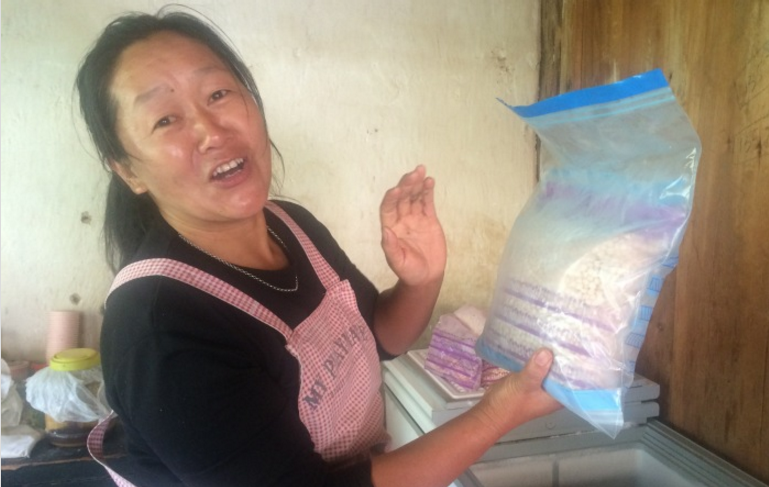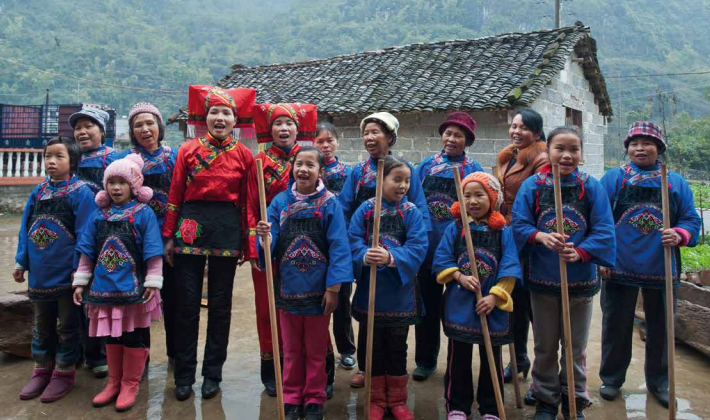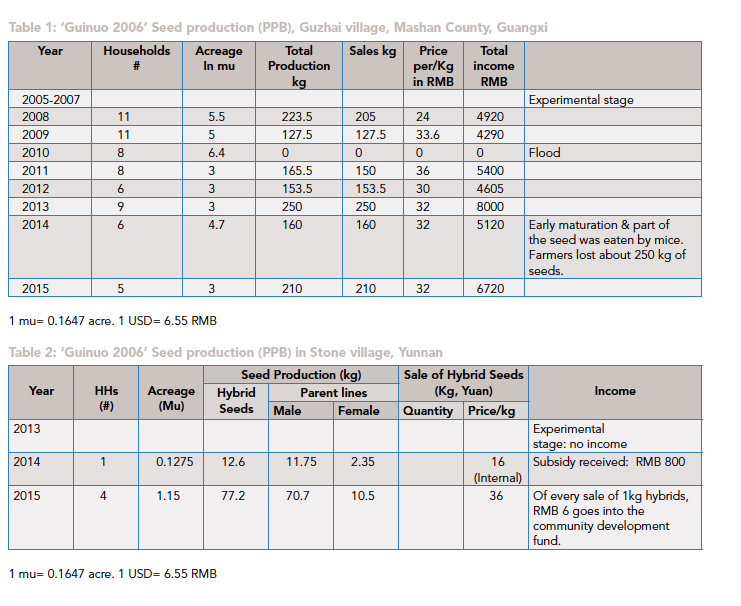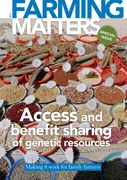This contribution discusses access and benefit sharing within the context of participatory plant breeding. It presents how Chinese farmers and breeders collaborate in relation to crop improvement and on-farm maintenance of plant genetic resources. Based on more than a decade of action-research, a number of institutional changes were accomplished as a result of the interactions between national and provincial breeding institutes, rural development researchers and local maize farmers. Although the respective legislation in China is not yet adequately formulated, access and benefit sharing can still be addressed in contracts and by labelling products of a particular geographic origin.

At the end of the 1990s, an assessment of the impact on smallholder farming in Southwest China of maize varieties released by the International Maize and Wheat Improvement Centre (CIMMYT) concluded that there had been a systematic separation of the formal seed system and farmers’ seed systems. Varieties that were bred and released by scientific institutions were almost never adopted by farmers in the remote mountainous regions of the Southwest due to their poor adaptability to local agroecological conditions.
At the same time, however, the assessment documented for the first time the local diversity of maize landraces that had been conserved in the farming communities studied, with more than 80% of farmers’ seed being supplied by their own seed systems. Inspired by this, researchers of the Centre for Chinese Agricultural Policy (CCAP) decided to set up a participatory plant breeding project in order to research the usefulness of local varieties in scientific breeding. Such varieties include farmer improved open pollinated varieties and landraces. The researchers also set out to explore the possibilities for adapting formally released varieties to local conditions.
This project started in 2000 and focused on the province of Guangxi (Southwest China), with the active collaboration of farmers in six villages, maize breeders from the Guangxi Maize Research Institute (GMRI, the provincial public breeding institute) and the Chinese Academy of Agricultural Sciences (CAAS, the national public breeding institute).
Funding came from the International Development Research Centre of Canada and the Ford Foundation with facilitation provided by sociologists and policy researchers of CCAP in Beijing.
Key role of farmer-breeders
Breeders of both the provincial and national breeding institutes reported that the genetic base of maize hybrids had become dangerously narrow, which renders crops more vulnerable to pests and diseases, especially in the face of climate change. These breeders were invited to farmers’ fields to discover for themselves farmers’ skills, knowledge and expertise in managing genetic diversity. Later in the process, farmers brought their varieties to CAAS and GMRI and shared their knowledge and experiences in seed selection. During the exchange visits the ‘professional’ breeders discovered that the farmers had conserved and improved Tuxpeño 1 (an open pollinated maize variety released much earlier by CIMMYT). They also learned that one farmer in particular, known as Aunt Pan from Wentan village, had improved a locally important variety of Tuxpeño 1 that had become widely popular in the surrounding local communities. Due to these interactions, they began to realise that the local landraces that had been conserved on-farm in the Guangxi communities could be a potential source of valuable new breeding material for professional breeders in the country.

The breeders from the national and provincial institutes gradually acknowledged and appreciated that local farmers could become valuable partners in seed development and improvement. As a result, Aunt Pan joined the research team to continue improving Tuxpeño 1. From 2000 to 2004, the project gradually became a research programme funded in part with Chinese resources, while the research team extended its activities to new communities in Guangxi and to two additional provinces in the Southwest: Yunnan and Guizhou.
These communities were situated in more remote areas. Farmers in these villages reportedly conserved an even larger diversity of landraces. In some of the communities, the research team identified other experienced farmer-breeders, such as in Stone Village in Yunnan. These farmer-breeders are continuing and expanding the crop improvement efforts first started in Guangxi, with women playing a central role. Farmers in the participating villages benefited from the experiments as they got access to improved seeds and were able to exchange these with farmers in surrounding villages, increasing the reach of benefits.
Testing the varieties beyond Guangxi
In 2003, with the support of the participatory plant breeding team, GMRI breeders allowed the first participatory bred variety Xin Mo 1 (an OPV) into the formal testing procedure for their value for cultivation and use (VCU test). There are two levels of VCU testing in China – one at the national level and one the provincial level. Xin Mo 1 was entered into the national testing procedure. In the Northern provinces it was entered at provincial level. However, likely due to different agroecological conditions, it did not perform as well as in the original trial villages of Guangxi and hence failed the VCU test.
As a result, the team reflected on the challenges to the registration of their products. They decided that henceforth open pollinated varieties would be released only in the trial villages and their neighbouring communities. The setback motivated the team to add a new research component to the program: a systematic review of national policies and laws impacting crop conservation and improvement with particular interest to finding legal space for variety release at subnational levels (see Selected Books).
Another important result of the programme was the release of a hybrid waxy maize variety, Guinuo 2006, in 2003. The variety had successfully passed VCU tests in a trial village and was registered through the GMRI. The subsequent commercialisation of Guinuo 2006 by a GMRI-owned seed company generated significant financial benefits for the professional breeders as it soon became one of the most popular waxy varieties on regional seed markets. Unfortunately, the farmerbreeders did not receive any of these financial benefits.
Farmers’ Rights
When Guinuo 2006 penetrated the commercial market the farmers who had participated in the adaptation testing of Guinuo 2006 became aware of the costs of purchasing their seed at market price. The team realised that it was unfair that the farmers who had contributed to seed development had to pay for using the seed. In order to help farmers save on the cost of seed and as a way to redirect benefits to the farmers participating in the participatory breeding project, the team initiated community based seed production of Guinuo 2006 in a number of trial villages in Guangxi. The seeds were produced and sold by the farmers, who now make some money from their sales and no longer have to buy seeds.
A unique benefit sharing agreement
In order to create some legal space for the community based seed production of Guinuo 2006, the team facilitated an agreement among GMRI breeders, the GMRI-owned seed company and the seed production villages. This initiative, a first in China and perhaps the world, was generally welcomed and the negotiations resulted in an agreement to share the financial benefits. The GMRI breeding institute and the associated seed company would supply the commercial market while allowing the farmers participating in the project to produce seed for local niche markets, such as the remote areas of Guangxi and nearby Southwest provinces, with the price set by farmers.
This unique agreement was based on the breeders’ desire to galvanise the existing mutual trust with farmer-breeders. As one of them explained: “We have collaborated with these farmers for a long time, we trust them as friends, and we would like to grant them small scale seed production in their communities.” Farmers expressed that they highly appreciated the support given by the professional breeders, which they consider a recognition of farmers’ contributions to the development of the new variety.
In 2005, two of the trial villages located in remote mountainous areas were selected for hybrid maize seed production. These locations were chosen because the breeders wanted to reduce the chances that the parental lines of the hybrid variety, which remained protected by their plant breeder’s rights, would be stolen by rival commercial interests.
This hybrid seed production through participatory plant breeding has been carried out by farmers in two villages in Guangxi since 2005 and has expanded to Stone Village in Yunnan in 2013 through farmer to farmer exchanges facilitated by the project team. The major challenge that farmers face is how to obtain full ownership and legal rights to the variety. Although the farmers who participate in the project and their communities consider that they have collective right to the variety, in China’s seed law collective rights are not yet accepted. Another major challenge is the insufficient policy and institutional support for farmers’ seed production, distribution and marketing.
Tensions: no formal framework
In order to better understand the emerging tensions between local practices in access and benefit sharing and national regulatory frameworks, an international exchange took place in 2009 of ABS experiences from four countries: China, Jordan, Peru, and Nepal. The meeting comprised a workshop in Beijing and a field visit to trial villages involved in participatory plant breeding in Guangxi. The relationship between ABS issues and national legislation, crop policy, and stakeholders’ interests became a focus of discussion at the workshop. Chinese officials working on ABS legislation from the Ministries of Agriculture and Environmental Protection participated in the discussion. An important discussion point was that according to the current plant variety protection regulation (1997) in China, farmers can in theory be recognised as joint breeders through a contracting arrangement. However, such an agreement is difficult to achieve in practice because the public breeders have a competing stake in plant genetic resources, and farmers’ rights can rarely be claimed through the plant variety protection law. Breeders can receive 100 yuan (about 15 USD) for each variety collected for a gene bank, but there is no payment to farmers if seeds are collected from their fields.
Also, it should be noted that in China the state ultimately has sovereign rights over all plant genetic resources while property rights have only been vaguely defined. Furthermore, China is not a signatory to ITPGRFA.To bypass these problems and compensate farmers for their contribution, CAAS breeders suggested refunding the farmers for the costs of maintaining the designated plant genetic resources in their fields to the value of 0.3-0.5% of any profit a commercial seed company may derive from that material. The GMRI breeders endorsed this idea, but when they discussed the proposal within their provincial institute, the institute’s commercial branch responsible for seed production and marketing objected because it would not bring commercial benefit to the seed company.
This episode exposed the opinions and interests of each stakeholder and even led to tensions within the GMRI. It was concluded that China lacks a common ABS framework at the national level and that this is creating uncertainty for emerging local practices.
ABS contract model from Taiwan
Faced with these challenges, in 2009 CCAP researchers started to negotiate an ABS contract with its stakeholders. CCAP had been inspired by an ABS contract model that was developed in Taiwan. The model requires recognition by name of any farmer who makes a contribution, as well as the creation of an enforceable fair benefit arrangement agreed by all the named parties, before a license for seed release is granted. As such, CCAP researchers recognised that the Taiwanese model law provided an alternative to arrangements based on exclusive rights and compels the balancing of interests among stakeholders in the public sector, commercial sector and farming communities.
Two types of contracts were developed in parallel for two potential purposes (a) to encourage in situ conservation (for breeding and agro-biodiversity enhancement), and (b) to fairly share the commercial benefit from market exploitation. The two contract types were signed by three public research institutes (including CCAP), two breeding institutes (GMRI and CAAS),and 12 farming communities in Guangxi in June 2010. In July 2010, the team reported the contract process to the officials of the Ministries of Agriculture (MoA) and Environmental Protection (MoEP) and discussed the feasibility of scaling up the practice at national level. MoEP officials proposed to integrate the team’s case experience into the national ABS discussion and supported the idea of setting up a national registration system for plant genetic resources and landraces as the first step required for international recognition of national ABS law.
Slow but steady progress
Fifteen years of ongoing and expanding field research in Southwest China combined with strategic policy research at provincial and national levels has resulted in growing recognition and appreciation of the synergies that can be created between the formal and informal seed systems in China. Given the scope and complexity of the institutional landscape in China this has been a remarkable achievement.
Fifteen years of field and policy research has resulted in a growing recognition of the synergies that can be created between the formal and informal seed systems in China
In recent years, CCAP, GMRI and CAAS have been joined by other Chinese research institutions to strengthen the efforts that were first started in a few communities in Guangxi. At the same time, lead agricultural policy organisations have become involved and have begun to incorporate the important results of the field research into relevant policies and laws in order to create a more supportive environment for the kind of approach piloted by the participatory plant breeding team. Hopefully, this will allow more farmers to benefit in the forms of recognition of their expertise, improved access to and availability of quality seeds and improved varieties, income generated from seed production and marketing, and the provision of scientific and technical knowhow through collaboration with the formal seed sector.
Yiching Song (songyc.ccap@igsnrr.ac.cn), Zhang Yanyan (Zhangyy8503@163.com) and Xin Song(Xinsong2014@163.com) are researchers at the Centre for Chinese Agricultural Policy, Chinese Academy of Sciences
Ronnie Vernooy (r.vernooy@cgiar.org) is a genetic resources policy apecialist at Bioversity International, Rome
This article builds on and updates previous publications on the same subject (see Further Reading 69-71). We acknowledge the contributions of a number of colleagues to these publications. We thank Robin Pistorius for his editorial work on this article.


